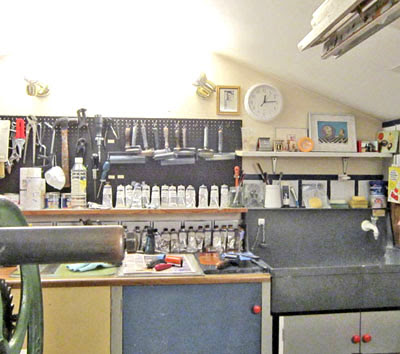The clock on the
wall is showing quarter past twelve: that's midnight,
not noon. When I next look up it will
probably say 3:30 or 4am but that's the kind of
time it usually is when I'm up there in my mansarde. I
cannot shake off the habit of working late. There must
be something about mornings which puts me off but I haven't
got time to analyse why and does it matter anyway? Getting
the work done is the main thing, never mind what time
of day or night.
Since I'm
blogging so infrequently I thought I would
show you some of what I'm doing which,
as I've mentioned before, is illustrating the long poem
by Blaise Cendrars Trans-Siberian
Prosody and Little Jeanne from France translated by Dick
Jones which will be published by The
Old Stile Press . I'm
creating about 48 images, and cutting as many blocks,
to be eventually hand-printed
by Nicolas McDowall. The photo above shows
the sink for damping paper etc. and the table
where I work out ideas. Before cutting the final blocks
out of vynil tiles, I work
out the design and colours for each image by
cutting trial blocks out of cardboard and proofing them
on my etching press.
I've had this press a very
long time and it has served me well - I printed most
of the images for my artist's
books on it. For
those who are not familiar with this simple machine,
an etching press resembles a mangle: the old-fashioned
kind that was used for wringing clothes. Except that
the baby photographed above consists of heavy solid steel
rollers, between which a steel bed is driven back and
forth by a geared wheel. Pressure is adjusted by turning
the top screws on either side of the frame. Special blankets
are laid between the top roller and the paper and plate
to be printed. The difference between an etching press
and a litho press or a relief press is that it's designed
primarily to print intaglio:
a design that is engraved or etched below the flat surface
of a plate - traditionally metal, but can also
be any material which will fit under
the etching press roller. Printing intaglio consists
of pushing ink into the lines, grooves and textures that
have deeply scarred the surface of the plate and then
wiping the surface clean. Damp paper is laid over the
plate and when it's passed under the roller, heavy
pressure pushes the paper into the grooves of the plate,
lifting out the ink, creating the intaglio image (always
embossed on the back of the paper).
More
recent presses are adaptable to both intaglio and
relief because the top roller can be lifted off the bed,
allowing blocks of any thickness to be printed. Unfortunately
my old press doesn't have this flexibility and, since
the blocks I'm cutting for this book will be printed
in relief (off
the flat surface of the block) they must be a lot
thicker than a normal intaglio plate. Therefore any
proofing I do doesn't show the same detail or texture
as it will eventually have on Nicolas' excellent relief
press.
My working process goes
like this: the text is of primary importance, it gives
me the rhythm and content of each page. I've made
a full-size (30cms x 28cms/ 12" x 11") dummy
in which I do rough drawings and/or collages in black
only. From these, I cut the first trial blocks out of
thin cardboard, proof them, then start cutting the final
vynil blocks, perhaps two or three blocks for each design
since they will be printed in colour: each colour
requires a separate block. Below is the working dummy open at
pages 8-9.
Below is one of the
finished vynil blocks for page 9: its strongly textured
(with gesso) surface doesn't show in the photo. The green
and red areas inside the main figure are actually holes
through which you're seeing the table behind. The holes
are so that the relief press rollers won't deposit ink
in those areas.
Below: roughs for pages
14-15
Printmaking demands equal and extreme
amounts of messiness and cleanliness in constant alternation.
Above, my inking table and rollers are
about to be cleaned. This procedure has to be repeated
many times during the day because ink (I use only oil-based)
mustn't be allowed to dry on slabs or rollers. The smell
of white spirit (turps) is pervasive so ventilation
is essential. That shark-like shape on the top right
in the picture below is the edge of an open Velux skylight
window - my studio is a converted loft.
A colour proof of page 7,
using three blocks. The text is only pasted
on and not printed as it will be in the final book.
Voilà, that's it for tonight.
The time is now five past 2 am.
MORE

























